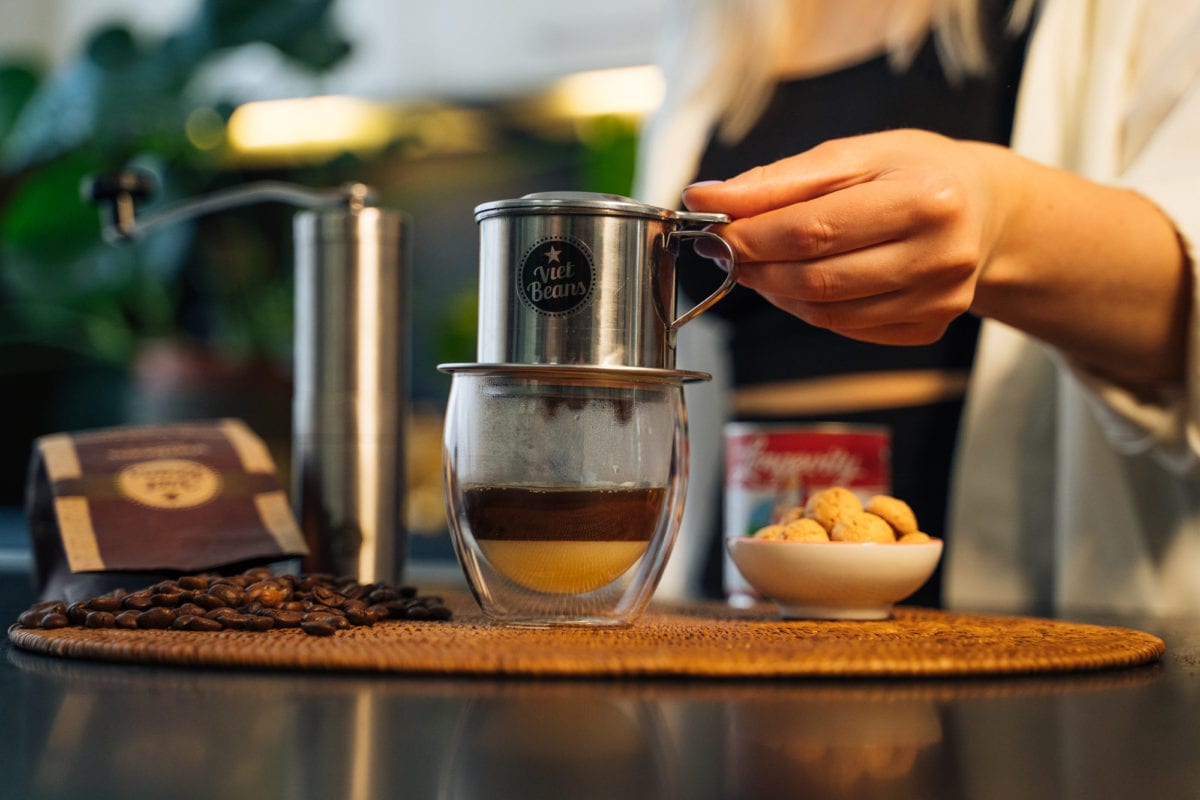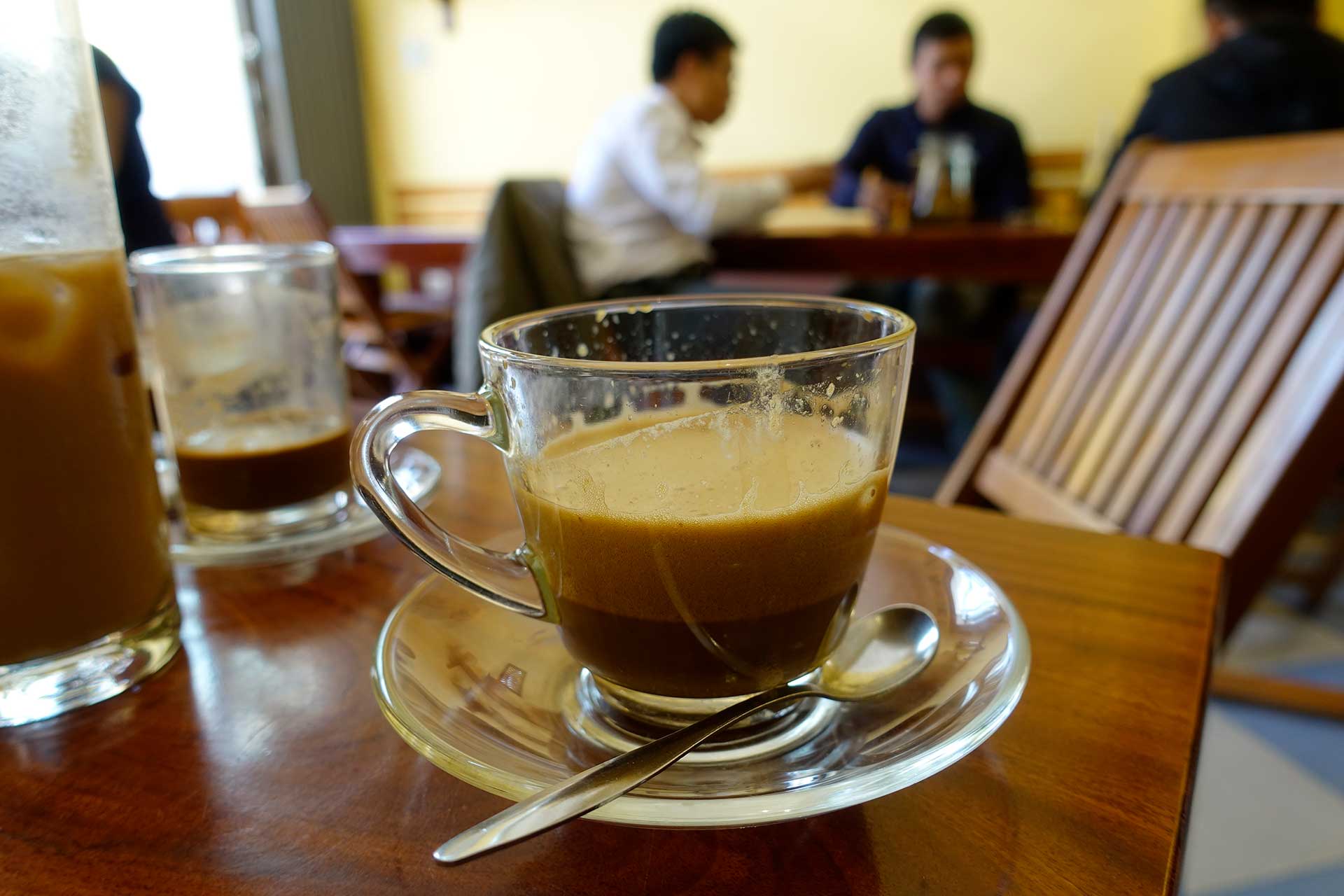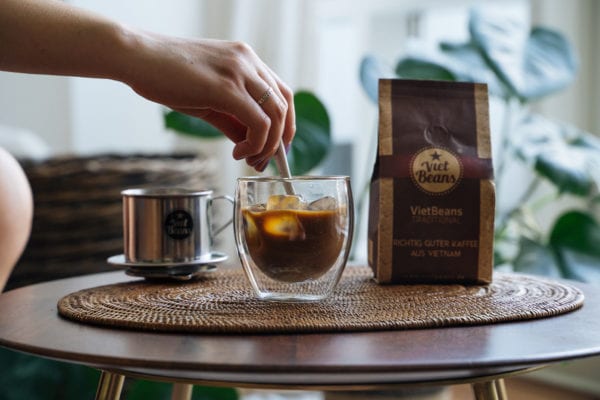More than just a brand: A journey through Vietnam's coffee culture
The Vietnamese coffee landscape offers much more than what is apparent at first glance. Many people in Germany know Trung Nguyen coffee in particular when it comes to coffee from Vietnam. No wonder, Trung Nguyen has established itself as the flagship for coffee from Vietnam in Germany. But the diversity of this unique coffee-growing country goes far beyond that.
In this article, we'll take you on a journey of discovery through the fascinating world of Vietnamese coffee. Not only will you get to know unknown but extremely tasty varieties, but we'll also show you how to prepare your coffee with a traditional Phin filter. We've also put together some special recipes and even our own coffee varieties and sets for you. Be surprised by the rich variety that coffee from Vietnam has to offer.

Trung Nguyen Coffee – The industry leader
Before we delve into the hidden treasures of Vietnamese coffee culture, it is worth taking a closer look at the top dog: Trung Nguyen. The company, founded in 1996 in Buon Ma Thuot, the heart of Vietnam's coffee region, has quickly become the country's best-known coffee roaster.
The company has not limited its business activities to the domestic market. It exports coffee to more than 60 countries, including heavyweights such as the USA, the EU and Germany. Their product range is impressively diverse: from various blends to the extremely successful G7 instant coffee and special accessories for making coffee.
Trung Nguyen's coffee chain is equally impressive. Since opening its first café in Ho Chi Minh City in 1998, the company has grown rapidly and now operates over a thousand branches across Vietnam. Trung Nguyen focuses on a wide range of coffee types and preparations, from Arabica and Robusta to innovative single-serve coffees for quick preparation.
Vietnamese coffee Trung Nguyen – What does it taste like?
Now that we have an overview of the Trung Nguyen company and its importance in the coffee world, the question naturally arises: what does the coffee actually taste like? Trung Nguyen offers an impressive selection of varieties, ranging from traditional Vietnamese flavors to modern fusions. Describing all of the varieties would go beyond the scope, so we want to focus on the three most popular varieties in Germany: Gourmet Blend, Creative 1 and G7 Instant Coffee.
The Gourmet Blend is characterized by its full-bodied taste and chocolatey aroma. Various beans such as Robusta, Arabica and Excelsa are mixed here. Interestingly, the chocolatey aroma is enhanced by artificial flavors, which can lead to mixed reactions among coffee lovers.
Creative 1 is Robusta in its purest form. This variety has an intense, earthy taste with a bitter note. Anyone who appreciates the strong taste and high caffeine concentration of Robusta will get their money's worth here.
And then there is the G7 Instant Coffee, which is known above all for its practicality. Packed in small bags, this variety combines the rich taste of coffee with creamy milk and sweetness. An all-in-one package for quick coffee enjoyment.
In Germany, in addition to these varieties, you can often find the Creative series with numbers 2 to 5, while the Sang Tao 1-5 varieties are particularly popular on the domestic Vietnamese market. So there is plenty of choice for the discerning palate, but it is worth looking beyond the Trung Nguyen plate.
Trung Nguyen as Vietnamese whole bean coffee?
After getting to know the different varieties and flavors of Trung Nguyen, the question naturally arises: Can you buy Trung Nguyen as a whole bean? Unfortunately, the answer to this is no. The company specializes in ground coffee and instant coffee varieties. So if you want to experience the full taste and aroma of freshly ground Vietnamese coffee beans, you won't find it at Trung Nguyen.
This may be a little disappointing for purists and coffee enthusiasts who like to have their coffee freshly ground, so anyone looking for whole bean coffee Vietnam will have to turn to other brands. It's a small drawback, especially considering how popular the brand is in various coffee circles.
But of course there are also advantages to ground or instant coffee, such as speed and convenience.
Other well-known Vietnamese coffee brands
Trung Nguyen is undoubtedly the most prominent brand in the Vietnamese coffee landscape, but it is far from the only one. Unlike other coffee-producing countries such as Brazil, Vietnam has a vibrant coffee culture and many large companies produce their coffee primarily for the domestic market. Several companies dominate the local coffee segment, each with their own characteristics and flavors. Here are some other important players in the Vietnamese coffee market:
- Vinacafe : This is a state-owned company and a subsidiary of the Vietnam National Coffee Corporation. Particularly well-known in Europe for producing instant coffee for the former Eastern Bloc, Vinacafe has diversified over time and now controls more than 50% of the domestic instant coffee market in Vietnam, well ahead of Nestlé.
- Highlands Coffee: Founded by an American of Vietnamese descent, Highlands Coffee has become one of the leading brands in Vietnam and the “Vietnamese Starbucks.” With a wide range of coffee options, from traditional Vietnamese to international varieties, a visit to one of their over 230 cafes is almost a must on a Vietnam vacation.
- Cong Ca Phe : This brand has established itself as a new place to be for high quality coffee. It is particularly known for its coconut coffee, which is popular with locals and tourists alike.
- Trâm Anh coffee : A family business that is characterized by its unique roasting technique and the use of organic fertilizers. The beans are roasted at low temperatures in drums and often refined with butter and high-quality alcohol such as rum or cognac, which gives them an exceptional aroma. You can also find Trâm Anh coffee in our shop!
While Trung Nguyen focuses on mass production and export, these brands offer a wide range of taste experiences and are especially popular in the domestic market. Each of these brands brings its own character and philosophy to Vietnam's diverse and rich coffee culture.
The big Robusta question
In the world of coffee, the Robusta bean holds a special position that is considered controversial by many. Vietnam, one of the world's leading coffee producers, focuses primarily on growing this type of bean. An incredible 90% of Vietnamese coffee production is Robusta, much of which is exported to over 60 countries. Only about 5% of the yield remains in the country for domestic consumption.

For a long time, the Robusta bean suffered from an image problem. It is known for its resistance to pests and its ability to thrive in less than optimal conditions. While these characteristics made it attractive to producers, they also led to a reputation as a "bad" coffee. Robusta is naturally less balanced in taste and contains twice as much caffeine as the finer Arabica variety. In addition, some coffee roasters "improve" their blends with colorings, artificial flavors or even soybeans and charcoal, which of course does not help the quality.
But the wind is changing. There are signs of a change of thinking, not only in Vietnam, but worldwide. More and more small Vietnamese coffee farmers are focusing on higher quality Arabica varieties and more controlled cultivation. But Robusta is also experiencing a quality offensive. The key to a "good" Robusta also lies in the right roasting. A carefully and slowly roasted Robusta can develop a distinctive aroma and reduce the amount of chlorogenic acid that is naturally contained in the bean. Robusta is particularly suitable for espresso because it keeps the crema - the golden foam on the coffee - stable.
So, next time you're faced with a choice, maybe don't rule out Robusta. When carefully processed and roasted, this underrated bean variety can offer a truly aromatic experience.
Making Vietnamese coffee: tradition meets diversity
The art of coffee preparation has a long tradition in Vietnam, which differs significantly from the mass production of filter coffee in other countries. If you want to enjoy authentic Vietnamese coffee, you cannot go past the traditional Phin filter. The Phin is a simple but effective drip filter with a sieve bowl. It is placed directly on the cup or glass into which the coffee is to drip.

After placing the Phin, fill it with coffee powder, ideally medium to coarse. Then place a small press on top and pour boiling water over the whole thing. There should only be enough water to allow the coffee to "swell" initially. After about 30 seconds, fill the filter completely with hot water and wait until it has completely run through. The lid of the Phin can then serve as a coaster for the filter to avoid unsightly stains.
Another important component of a traditional Vietnamese coffee is the addition of sweetened condensed milk. Usually one to two teaspoons of this is added to the glass or cup before the coffee is poured in. The result is a sweet and full-bodied drink that is often served as iced coffee to match the tropical heat of Vietnam.
For illustrated instructions on how to make Vietnamese coffee and a short video, click here .
But even though the Phin is the traditional tool for Vietnamese coffee, that doesn't mean it's the only option. Vietnamese coffee can also be prepared in a French press, a portafilter machine or a fully automatic machine. The key is choosing the right beans and the right grind . However, it should be noted that the special character of Phin-brewed coffee cannot be completely reproduced by other methods. This automatically makes the coffee a little more "European".
Taste profile: What makes Vietnamese coffee so unique?
When you take your first sip of Vietnamese coffee, you'll quickly realize: this isn't your average coffee. The beans grown in Vietnam have a flavor profile all their own. It's a coffee that stands out for its intensity and complexity. While there's a wide range of flavors depending on which type of bean is used, the typical Vietnamese coffee tends to be bold, chocolatey, and a little nutty.
This Vietnamese coffee chocolate flavor is one of the characteristic features that attracts many coffee drinkers. This chocolatey note is further emphasized by the addition of sweetened condensed milk. The condensed milk adds a creamy sweetness that turns the chocolatey coffee into a real explosion of flavor.
Although Vietnamese coffee is naturally strong and aromatic, it retains its original tart "coffee" character despite the sweetness of the condensed milk. This is an important point for those who believe that coffee and sweetness don't go together. In this case, the sophisticated blend of bold, dark flavors and the sweet, rich texture of the condensed milk creates an amazingly balanced taste sensation. The coffee is strong enough that it can perfectly balance the sweetness without losing its deep, rich character.
To the unprepared palate, Vietnamese coffee can be quite intense, almost like an espresso, so it's not uncommon for tourists in Vietnamese cafes to be given some hot water to dilute the coffee.
Coffee specialties from Vietnam: A delight for every taste
Vietnam has a lot to offer not only in terms of culinary delights, but also when it comes to coffee. Aside from the traditional black coffee, there are numerous varieties that can captivate any coffee lover. Here are some of the most interesting coffee specialties from the country:
Cà Phê Trứng (Vietnamese egg coffee)

This coffee is a real treat for the taste buds. Known as "liquid tiramisu," this coffee combines strong espresso notes with egg yolks and sweetened condensed milk. Whipped to frothy perfection, this mixture is then poured over freshly brewed coffee. For anyone who loves chocolatey coffee variations, Cà Phê Trứng is an absolute must. If you want to know how to prepare Cà Phê Trứng properly, check out our blog post about it.
Ca Phe Sua Da (Vietnamese Iced Coffee)

On hot days, there is nothing more refreshing than a Ca Phe Sua Da. Strong, black coffee is mixed with sweetened condensed milk and then served over ice. This mixture blends right before your eyes and offers an experience that is as visually appealing as it is tasty. As temperatures rise, this coffee is also gaining popularity in other countries. We also have a separate blog post for Vietnamese iced coffee.
Cafe Sữa Chua (Vietnamese yogurt coffee)

This variant brings a whole new dimension of taste into play. The slightly sour yogurt complements the strength and intensity of the Vietnamese coffee and is rounded off with sweetened condensed milk. The result is a refreshing summer drink that not only invigorates but also pampers the taste buds.
Whether you like it traditional or are more experimental, in Vietnam you will always find a coffee specialty that will delight your palate. And the best thing is that you often prepare your coffee yourself at the table, thanks to a metal filter that is positioned above the glass. This means that every sip is a freshly prepared taste experience.
Self-promotion: Your one-stop shop for Vietnamese coffee
If all these fascinating coffee specialties from Vietnam have made you curious, we have good news for you. In our shop you can easily order everything you need to make Vietnamese coffee. From high-quality beans to special Vietnamese coffee filters, we have everything on offer.
Our carefully curated sets and affordable bundles are particularly popular. They contain everything you need for traditional preparation and are ideal for beginners who want to discover the variety of coffee from Vietnam. Such a set is also a wonderful gift idea for all the coffee lovers in your life.
So, what are you waiting for? Buying Vietnamese coffee has never been so easy and convenient. Discover our selection now and soon you can enjoy your homemade, traditionally prepared Vietnamese coffee.





